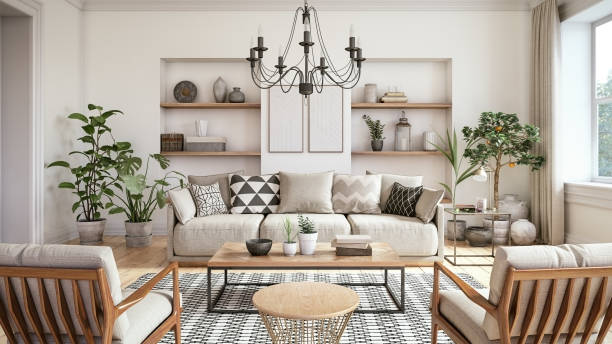
Drawing inspiration from global design traditions in interior design can transform your space into a vibrant tapestry of culture, history, and innovation. At Cityfurnish, we understand the importance of incorporating diverse design elements into modern living spaces.
Table of Contents
ToggleOur furniture rental services are designed to meet the dynamic needs of our customers, offering everything from contemporary furniture and traditional pieces to fusion collections that blend elements from various cultures and design traditions.
Embrace your inner design diva and let your creativity soar as you explore various styles with this approach. No need to break the bank or commit to a lifetime of furniture ownership – it’s all about flexibility and discovering what truly resonates with your unique taste!
This article examines various global design traditions, inspiring different cultures to incorporate a mix of traditional and contemporary styles into the home.
Exploring Global Design Traditions: Inspiration from Around the World
Exploring global design traditions offers inspiration for those looking to infuse their spaces with unique, culturally rich aesthetics. From the intricate patterns of Indian textiles to the minimalist elegance of Scandinavian design, each tradition brings its own unique flavor to the table. Here’s a concise exploration of design inspirations from around the world:
- Scandinavian Simplicity: Characterized by minimalism, functionality, and natural light and materials. This design tradition emphasizes clean lines, neutral colors, and a connection to nature, creating serene and spacious interiors.
- Japanese Zen: Focuses on simplicity, natural beauty, and tranquility. Key elements include sliding doors, tatami mats, and a neutral color palette to create a peaceful, contemplative space.
- Indian Vibrancy: Known for its vibrant colors, rich patterns, and abundant textures and materials. Indian design incorporates ornate furniture, colorful textiles, and intricate details, reflecting the country’s diverse cultural heritage.
- Moroccan Elegance: Features bold colors, intricate tile work, and detailed wood and metal work. Moroccan spaces often include plush fabrics, ornamental lanterns, and a blend of textures, creating a luxurious and inviting atmosphere.
- Italian Rusticity: Combines rustic charm with elegance. Key elements include terracotta tiles, exposed wood beams, and a warm color scheme. Italian design often incorporates open kitchens, large dining areas, and a blend of modern and traditional furnishings.
- African Textures: Rich in textures and patterns, African design includes handwoven textiles, tribal patterns, and artisanal pieces. Materials like wood, leather, and metal are commonly used, alongside vibrant colors and earth tones.
- Mexican Colorfulness: Distinguished by its use of bright colors, folk art, and handmade items. Mexican interiors often feature tiled surfaces, colorful fabrics, and rustic wooden furniture, reflecting a lively and warm aesthetic.
- French Elegance: Known for its sophistication, French design mixes old-world charm with contemporary elements. Key features include ornate details, soft color palettes, and luxurious textiles, creating chic and timeless spaces.
Key Elements of Traditional Indian Furniture and Decor
Intricate carvings, bold colors, and the use of traditional materials like wood and metal characterize Indian furniture and decor. Indian decor often incorporates flowery and geometric patterns, reflecting the country’s rich heritage.
Furniture frames made from teak or Sheesham wood offer durability and add a touch of elegance to any space. Incorporating Indian furniture into your home can create a warm and inviting atmosphere enriched with the history and craftsmanship of Indian culture.
African patterns, known for their vibrant colors and dynamic motifs, can add a powerful statement to modern designs. These patterns, inspired by nature and tribal folklore, can be integrated into home decor through textiles, artwork, and even furniture choices. African design’s bold geometric patterns and earthy tones can complement contemporary furniture, creating a fusion of tradition and modernity that enriches the living space.
Benefits of Using Natural Materials in Home Decor
Using natural materials in home decor brings warmth and texture to your space and has a positive environmental impact. Materials like wood, stone, and bamboo are sustainable and add an organic touch to interiors. Furniture and decor crafted from natural materials create so many advantages:
- Aesthetic Appeal: Adds timeless beauty with unique textures and colors, creating a warm, inviting atmosphere.
- Durability and Longevity: Natural materials like hardwood and stone are strong and resistant to wear, offering decades of use.
- Health and Wellness: Emit lower levels of VOCs, improving indoor air quality and promoting mental well-being.
- Sustainability: Often renewable, biodegradable, or sustainably sourced, reducing environmental footprint.
- Versatility: Complements any design style, from rustic to modern, adaptable to various themes.
- Thermal and Acoustic Insulation: Provides better insulation, keeping homes warmer in winter and cooler in summer and reduces noise levels.
- Connection to Nature: Strengthens the connection to the outdoors, improving mood, reducing stress, and enhancing creativity.
How Do Fusion Furniture Collections Combine Different Design Traditions?
Fusion furniture collections are at the forefront of a design trend that blends elements from various cultures and eras. These collections often merge the sleek lines of modern designs with traditional craftsmanship, such as oriental furniture details or Indian patterns.
The result is a unique and eclectic mix that stands out in any setting. Fusion furniture allows for personal expression and brings a global perspective to interior design, making it a popular choice for those looking to create a distinctive space.
Geometric patterns can add depth and interest to your home decor. Consider using high-quality images and textiles to ensure a sophisticated look when incorporating these patterns. Geometric patterns can be balanced with solid colors to avoid overwhelming the space.
They work well in contemporary furniture pieces, adding a dynamic and modern touch. Whether through accent pillows, wall art, or area rugs, geometric patterns can enhance the aesthetic appeal of your home.
Final thoughts!
In conclusion, exploring global design traditions offers endless inspiration for creating meaningful and stylish spaces. By blending elements from different cultures, such as Indian furniture, African patterns, and natural materials, you can create a home that reflects a rich tapestry of global influences. Remember, the key to successful interior design is finding the right balance between tradition and modernity, ensuring your space is timeless and on-trend.

